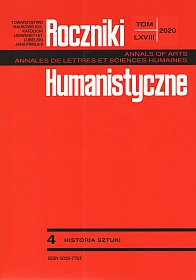O reminiscencjach konfliktu o ordynację ostrogską w sztuce kręgu Jana Klemensa Branickiego
The reminiscences of the conflict over the Ostrogski Ordination in the art of Jan Klemens Branicki’s circle
Author(s): Krzysztof GombinSubject(s): Fine Arts / Performing Arts, Visual Arts, History of Art
Published by: Towarzystwo Naukowe KUL & Katolicki Uniwersytet Lubelski Jana Pawła II
Keywords: Ostrogski Ordination; Jan Klemens Branicki; Palace in Białystok; Rotator of Białystok
Summary/Abstract: According to more recent research, the sculpture from the staircase of Jan Klemens Branicki’s palace in Bialystok, most often referred to as Rotator (“Rotating”) or Arrotino (“Knife Grinder”) may have depicted one of the Roman heroes (Vindictius, Milichus or Fenius Rufus) who, while doing his job, overheard the conspirators and thus thwarted their scheming. It was supposed to be an allusion to the role of Hetman Jan Klemens Branicki (the founder of the sculpture) in the contemporary events – the conflict over the Ostrogski Ordination. This thesis is confirmed by handwritten satires, created in connection with the dispute over the ordination (Łysa rada kolbuszowska [The Bald Council of Kolbuszowa] and Scena tragiczno-komiczna na… [A Tragicomical Scene]), of which Branicki is one of the main characters. In Scena tragiczno-komiczna na, the division of the ordination was presented as a conspiracy against the Polish-Lithuanian Commonwealth, which was discovered and pacified by Hetman Branicki and his army. He started these actions on his own during the king’s absence, becoming the most important person in the country and the man of the moment, and then completed them in cooperation with the returning monarch. Thus, the Rotator from Białystok can be referred to Branicki, the beloved Polish son, a loyal subject and a great military leader who prevented civil war. In the journalistic texts related to the dispute over the Ostrogski Ordination, Branicki was also compared to his ancestor, Hetman Stefan Czarniecki, as similarly to him, he would prevent the Polish-Lithuanian Commonwealth from the internal conflict. Stefan Czarniecki is a very popular character in Białystok, often depicted in sculptures and paintings ordered by Branicki. In fact, Branicki did not have any serious merits as a hetman; it was only from the perspective of the dispute over the ordination and his portrayal as a great leader and the man of the moment that the cultivation of the memory of Stefan Czarniecki gained a special importance.
Journal: Roczniki Humanistyczne
- Issue Year: 68/2020
- Issue No: 4
- Page Range: 191-203
- Page Count: 13
- Language: Polish

